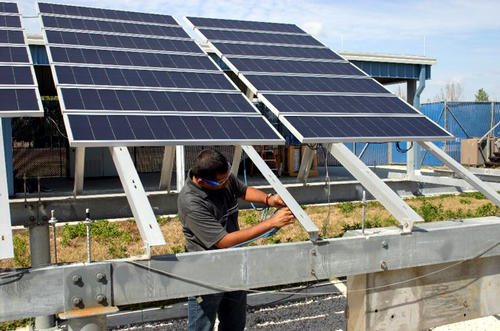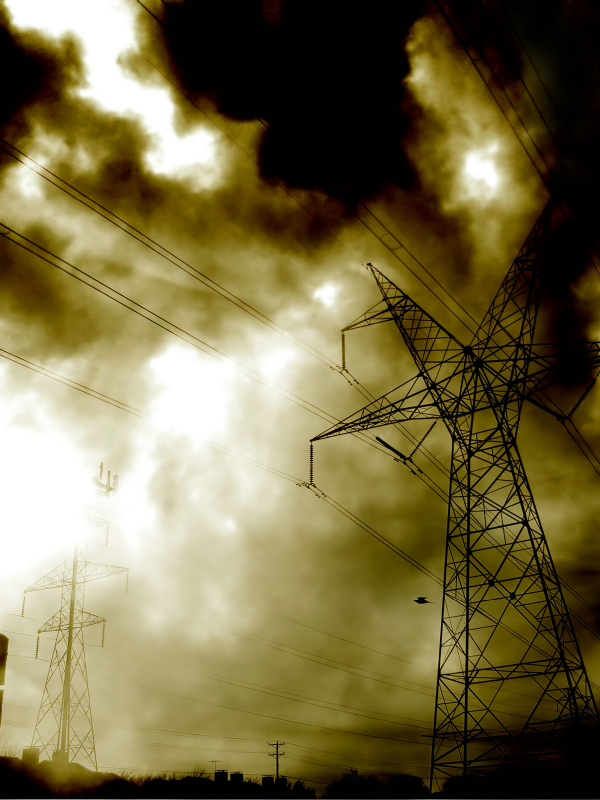First Things First: Cars, trucks, planes, and other things that go add more greenhouse gas to the atmosphere than any other sector where end-users burn their own fuel. And transportation added more energy-and-climate headlines this week than any other sector, driven by an emergency congressional payout to continue the “cash-for-clunkers” program and General Motors’ promotional campaign for the Chevy Volt, its plug-in hybrid electric-and-gas car.
GM’s message is simple enough: “230.” That’s the number of miles that the carmaker says the Volt can travel per gallon of gas, news greeted with a mix of exuberance and skepticism. Many reporters, analysts, and bloggers see symbolism in Chevy’s very announcement, namely, that the company has chosen to speak of its future in the language of the past. By measuring the Volt against the traditional miles-per-gallon yardstick, GM is fixing the electricity-powered car in the framework of gasoline. The Volt is expected to cost about $40,000 and go on sale at the end of 2011. Question: Could a “cash-for-chargers” program be far behind? Another question: If it’s true, as a former GM official once famously said, that “you don’t roll out a new product in August,” what does an August roll-out say about GM’s enthusiasm for this project?
GM faces nascent and possibly significant competition from upstart companies, such as Coda Automotive and Bright Automotive, who are trying to forego the Detroit business model of having all aspects of production and distribution under one corporate roof.
Department of Chickens and Eggs: The benefits of moving away from gasoline- and diesel-powered automobiles, toward non-polluting energy, are well-known: lower carbon dioxide emission levels; extrication from petro geopolitics; a diminishing numbers of car explosions in summertime Hollywood blockbusters. For a fleet of electric cars or hybrids to succeed in replacing them, there must be enough electricity. And the trouble with electricity is that producers find it difficult, once they’ve generated it, to pour it into a pipeline, supertanker, or a hazmat truck. What they need are power lines, which are unsightly, and batteries, which are commercially immature.
If Americans will charge their electric cars at home 90 percent of the time, as predicted, then electric and hybrid fleets will require that much more electricity be conveyed to homes. Power companies will need to both meet new demand for power and manage it wisely. That’s where the “smart grid” comes in. The smart grid is a suite of technologies and behaviors to help power flow smoothly and predictably from generator, to grid, to users (and if they generate more than they need, back to the grid). The clean tech firm GridPoint’s development of software to help utilities monitor and predict plug-in owners’ charging habits is a quieter parallel development to GM’s launch of its Volt campaign.
Beyond batteries and new generation transmission, there are plenty of “clean tech” stories to go around while the solar industry works out its monumental supply glut. And venture capitalists familiar with these developments are finding themselves in influential positions–even in the public sector public sector.
A Clunker of a Program (Full Stop?): An emergency $2 billion tranche will sustain the popular “cash for clunkers” program after it depleted its initial $1 billion treasury. Three criticisms tend to arise: the mileage of approved replacement cars is too low; the program rewards “bad” choices—buying inefficient cars; and marginal auto efficiency improvement are unlikely to produce benefits in financial savings as large as those generated by reducing buildings’ energy waste, or promoting healthier lifestyles.
Part economic stimulus, clunkers-inspired car buying lifted sales 2.4 percent in July and led Ford to ramp up production. The auto sales spike could not alone carry overall retail sales into positive territory. The LAT lays out a loophole in the clunkers legislation, large enough to drive, um, a truck through. The Car Allowance Rebate System (CARS), the actual name of the legislation, exempts cars built before 1984, a request by the antique auto-parts lobby: “The final wording of the bill, including the provision requested by the interest group, was ironed out in a legislative conference committee and attached to a military spending bill.” A New York Times lede and a Los Angeles Times photo suggest a marketing trend of dealerships displaying “clunkers” in dumpsters as a signal that they are participating in the program. The NYT Web headline, “A Clunker of a Program?”, demonstrates the time-tested practice of a publication adding a question mark to a non-neutral statement of opinion to make it look like a neutral query.
Senate Climate Bill Goes Down Down Under: The Australian Senate defeated legislation that would have set up a national carbon emissions trading program. Climate change down under divides national political parties on a level the topic has not yet reached in the United States.
Though their political situations have little in common with the Australians, the Democratic leadership of the U.S. Senate also faces political obstacles to passage of a climate bill. For one, this week included an estimate that puts the program’s ten-year bureaucratic price tag at $8 billion (The costs of inaction are more difficult to quantify with a pat number). Looming larger, president Obama faces opposition in the Senate from Democrats whose states rely on coal for electricity and manufacturing for jobs. Ten Democratic senators signed a letter to the Obama, requesting relief in legislation in the form of border tariffs on goods from countries without climate policies and rebates to offset higher energy costs.
New analyses of legislation by lobbying groups means, among other things, more fodder for he-said, she-said political rhetoric and subsequent reporting. (He said:) The National Association of Manufacturers rolled out its cost modeling of the House climate-and-energy bill that passed in June, projecting 2 million U.S. job losses and a 2 percent drop in GDP by 2020. The assumptions that went into the modeling are not yet released but (she said:) the Environmental Defense Fund is eager to discredit them. See this for a lengthy treatment about last year’s tete-a-tete between NAM and EDF, and why not all economic models are equal but are sometimes presented that way in quickly written, grotesquely simplified paragraphs like this one.
Attention to the particulars of climate policy will ramp up as the fall legislative season begins, and the Senate tears into its version of the House bill. Seed magazine is ahead of the game, offering an explainer about “carbon offsetting,” that includes views of five experts, including colleague Brian Murray, the Nicholas Institute’s director of economic analysis and an IPCC economist
The Electric Kool-Aid Acid Bath: People enjoy the oceans both because they are pretty and because they absorb anthropogenic carbon dioxide, slowing its atmospheric accumulation and trapping of heat. Thanks, oceans. That said, ocean creatures do enjoy their water at specific temperatures, depths, salinity, and alkalinity. As the seas absorb increased carbon dioxide from the atmosphere, oceans’ chemistry changes, becoming less alkaline–or, as it has become commonly known, more acidic. Scientists are studying the effects of ocean acidification on creatures large and small, hoping to glean what this monumental change could mean for the fate of the human presence on and in oceans, marine ecosystems, and by extension the path of carbon from deep Earth, to power plant, to sky, to sea.
Coming off the Earth’s second hottest July in recorded history (about 150 years), it’s nice to think about ice, keeper of its own recorded history (about 800,000 years). One thing that makes climate so difficult to write about is that so much of potential change is clear and so much of it is not clear. If only there were a way to democratize science, so that sitting at your desktop you can see the ice for yourself, where it comes from, and how scientists study it.
The Climate Post offers a rundown of the week in climate and energy news. It is produced each Thursday by Duke University’s Nicholas Institute for Environmental Policy Solutions.




